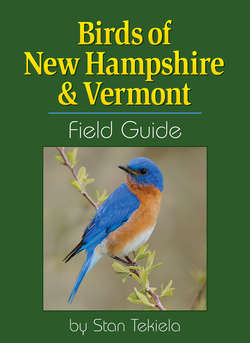Читать книгу Birds of New Hampshire & Vermont Field Guide - Stan Tekiela - Страница 12
На сайте Литреса книга снята с продажи.
Bird Color Variables
ОглавлениеNo other animal has a color palette like a bird’s. Brilliant blues, lemon yellows, showy reds and iridescent greens are commonplace within the bird world. In general, the male birds are more colorful than their female counterparts. This is probably to help the male attract a mate, essentially saying, “Hey, look at me!” It also calls attention to the male’s overall health. The better the condition of his feathers, the better his food source and territory, and therefore the better his potential for a mate.
Female birds that don’t look like their male counterparts (such species are called sexually dimorphic, meaning “two forms”) are often a nondescript color, as seen in Indigo Buntings. These muted tones help hide the females during weeks of motionless incubation, and draw less attention to them when they are out feeding or taking a break from the rigors of raising their young.
In some species, such as the Bald Eagle, Blue Jay and Downy Woodpecker, male birds look nearly identical to the females. In the case of woodpeckers, the sexes are differentiated by only a single red mark or sometimes a yellow mark. Depending upon the species, the mark may be on top of the head, face, nape of neck or just behind the bill.
During the first year, juvenile birds often look like the mothers. Since brightly colored feathers are used mainly for attracting a mate, young non-breeding males don’t have a need for colorful plumage. It is not until the first spring molt (or several years later, depending on the species) that young males obtain their breeding colors.
Both breeding and winter plumages are the result of molting. Molting is the process of dropping old worn feathers and replacing them with new ones. All birds molt, typically twice a year, with the spring molt usually occurring in late winter. During this time, most birds produce their breeding plumage (brighter colors for attracting mates), which lasts throughout the summer.
Winter plumage is the result of the late summer molt, which serves a couple of important functions. First, it adds feathers for warmth in the coming winter season. Second, in some species it produces feathers that tend to be drab in color, which helps to camouflage the birds and hide them from predators. The winter plumage of the male American Goldfinch, for example, is olive brown unlike its obvious canary yellow color during summer. Luckily for us, some birds, such as the male Northern Cardinal, retain their bright summer colors all year long.
